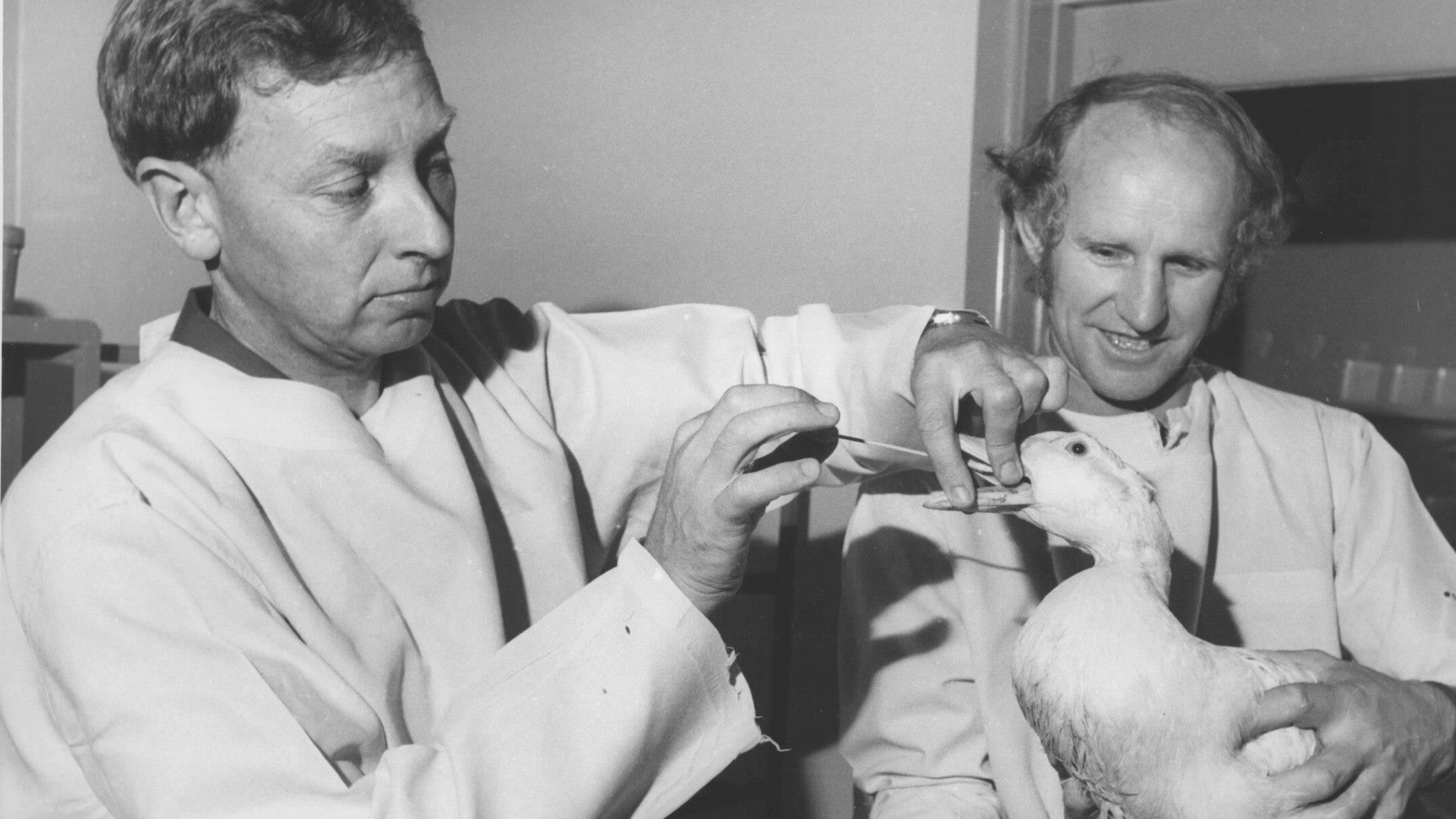
Professors Graeme Laver and Robert Webster testing for the influenza virus on a duck. (Supplied: ANU Archives)
When Graeme Laver was strolling along the New South Wales coastline in the 1960s very little was known about the origins of influenza pandemics sweeping the globe.
Professor Laver, alongside virologist Robert Webster, came across a beach littered with dead wedge-tailed shearwaters.
At the time, the virus had been discovered in domestic birds like ducks, but little was known about influenza in wild birds.
Professor Laver set out to test shearwater birds and uncover the structure of the virus, which led to breakthroughs in how influenza was treated, as well as leading to anti-viral drugs such as Tamiflu and vaccine improvements.
“Because mutton birds nest in burrows on barrier islands off the coast … Graeme decided that it would be a ‘bit of a joke’ to test birds on the Great Barrier Reef for influenza,” Professor Webster wrote in a biography.
Professor Laver’s “joke” still informs an understanding of and treatment of influenza viruses today.
It comes as Australian health departments are on alert for a possible spike in flu hospitalisations this year, with more than 7,000 cases in Queensland recorded so far this year.
‘Laver is hallucinating’
Tryon Island is a remote, tiny coral cay island at the southern end of the Great Barrier Reef, about 86 kilometres from Gladstone.
In 2004, Professor Laver wrote:
“We toyed with the idea of doing this on the coral islands of the Great Barrier Reef.
“Why there? Can you think of a more unlikely place to look for flu?
“Beautiful islands in an azure sea, hot sand, a baking sun, and a warm coral lagoon.
“What better place to do flu research!”
In 1969 he secured $500 in funding from the World Health Organization to begin his expedition.
In later years, he said “this was just as well as my head of department at the Australian National University, when asked for funds for an expedition to look for the flu on the Great Barrier Reef, said ‘Laver is hallucinating'”.
“He also said that in any case I wouldn’t be able to catch the birds,” he said.
“But I knew that thousands upon thousands of mutton birds, or shearwaters, nested on the coral cays of the reef in burrows in the sand, and that all you had to do to catch these wild, free-flying sea birds was to bend over and pick them up.”
A lifelong obsession
After Professor Webster found birds on Tryon which had been infected with influenza, Professor Laver mixed parts of the human virus with a part of the bird samples to look at how the flu could be prevented.
Senior librarian at the Queensland State Library, Christina Ealing-Godbold, studied their work and said the virologist tested hundreds of birds as part of this study, which proved the virus could be inhibited.
“This was a huge breakthrough because they didn’t understand what was causing these pandemics,” Ms Ealing-Gobold said.
“It was his lifetime obsession to try and solve the irregular pandemic upheavals that have dominated medical science for so many years.”
Professor Laver even sent samples from a black noddy bird to a Russian space station to grow under microgravity conditions.
The endeavour was later abandoned as the crystals were found to grow almost as well on land.
Californian pharmaceutical company Gilead Science used Professor Laver’s research to develop the anti-viral drug Tamiflu, which is still available today.
News Related-
High court unanimously ruled indefinite detention was unlawful while backing preventive regime
-
Cheika set for contract extension as another Wallabies head coaching candidate slips by
-
Analysis-West's de-risking starts to bite China's prospects
-
'Beyond a joke' Labor won't ensure PTSD protections: MP
-
Formula One season driver ratings: Lando Norris shines as Max Verstappen nears perfection
-
Catalina golfer Tony Riches scores Guinness World Record four holes in one on same hole
-
Florida coach Billy Napier fires assistants Sean Spencer, Corey Raymond with expected staff shakeup ahead
-
Rohingyan refugee NZYQ accidentally named in documents published by high court
-
Colorado loses commitments of 2 more high school recruits
-
Queensland Health issues urgent patient safety alert over national bacteria outbreak
-
Townsville Community Pantry 'distressed' by fruit, vegetable waste at Aldi supermarket
-
What Is The Beaver Moon And What Does It Mean For You?
-
Labor senator Pat Dodson to resign from politics due to health issues
-
Hamas releases 11 more hostages, as Israel agrees to extend ceasefire
